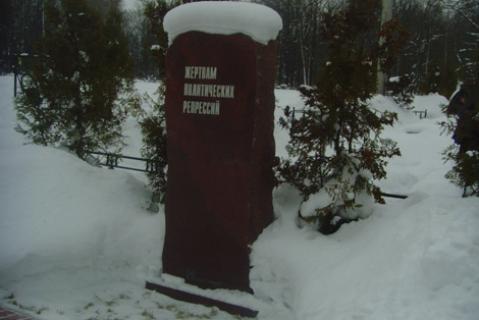In 1931// the Transfiguration (Preobrazhenskoe) Graveyard, in existence since the early 1870s, was renamed the “9 January graveyard” by the Bolshevik government. A monument to those shot during the protest on Bloody Sunday, 9 (22) January 1905, was unveiled at the cemetery where many of the dead protestors had been openly buried. In the 1920s to 1940s, meanwhile, the bodies of those who died or were shot in Leningrad’s prisons, especially during the Great Terror, were secretly interred there. No grave-markers distinguished the places they were buried: these became known thanks to the testimony of eyewitnesses.
The total numbers executed and reburied there have not been established; only individual names are known. In 2001, Memorial in St Petersburg successfully proposed that a monument dedicated to “The Victims of Political Repression” be added to the cemetery.
The Leningrad Martyrology, 1937-1938: A Book in Remembrance of the Victims of Political Repression (11 vols. 1995-2011) included biographical entries on 37,500 who were shot or sent to the camps. See volume 5.
The Memorial database (2025) lists 53,831 victims in the Leningrad Region. See Levashovo.
47,379 were shot, almost all during the Great Terror (47,142). Cases against 391 other individuals were closed; 32 of them died in custody. The executions include many of those first sent to the camps or deported to special settlements. 6,000 had earlier been sentenced to 5-10 years in the camps: 2,495 of them were shot. Of those previously deported from the Region with their families (1,648), no less than 1,066 were shot. Another 401 died in captivity, many of them already sentenced to death (242).
| State of burials | Area | Boundaries |
|---|---|---|
|
have not survived
|
not determined
|
not delineated
|
[ Original texts & hyperlinks ]
V.M. Lukin, “The commemorative ‘Victims of 9 January’ cemetery” in Kobak and Piryutko (compilers) The historic cemeteries of St Petersburg: A guide and reference work, St Petersburg, 1993
Leningrad Martyrology, 1937-1938: A book of remembrance about the victims of political repression, Vol. 5, St Petersburg, 2002
“Prison dead and shot, buried in St Petersburg’s ‘Victims of 9 January’ cemetery”, Virtual Museum of the Gulag [partially retrieved, 4 June 2022; not accessible]


